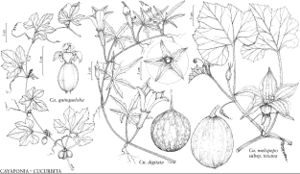Difference between revisions of "Cayaponia quinqueloba"
Field & Lab. 25: 32. 1957.
FNA>Volume Importer |
imported>Volume Importer |
||
| (6 intermediate revisions by 2 users not shown) | |||
| Line 13: | Line 13: | ||
}}{{Treatment/ID/Special_status | }}{{Treatment/ID/Special_status | ||
|code=F | |code=F | ||
| − | |label= | + | |label=Illustrated |
}} | }} | ||
| − | |basionyms={{Treatment/ID/ | + | |basionyms={{Treatment/ID/Basionym |
|name=Arkezostis quinqueloba | |name=Arkezostis quinqueloba | ||
|authority=Rafinesque | |authority=Rafinesque | ||
| + | |rank=species | ||
| + | |publication_title=New Fl. | ||
| + | |publication_place=4: 100. 1838 | ||
}} | }} | ||
|synonyms={{Treatment/ID/Synonym | |synonyms={{Treatment/ID/Synonym | ||
|name=Bryonia boykinii | |name=Bryonia boykinii | ||
|authority=Torrey & A. Gray | |authority=Torrey & A. Gray | ||
| − | }}{{Treatment/ID/Synonym | + | |rank=species |
| + | }} {{Treatment/ID/Synonym | ||
|name=Cayaponia boykinii | |name=Cayaponia boykinii | ||
|authority=(Torrey & A. Gray) Cogniaux | |authority=(Torrey & A. Gray) Cogniaux | ||
| − | }}{{Treatment/ID/Synonym | + | |rank=species |
| + | }} {{Treatment/ID/Synonym | ||
|name=C. grandifolia | |name=C. grandifolia | ||
|authority=(Torrey & A. Gray) Small | |authority=(Torrey & A. Gray) Small | ||
| − | }}{{Treatment/ID/Synonym | + | |rank=species |
| + | }} {{Treatment/ID/Synonym | ||
|name=Melothria grandifolia | |name=Melothria grandifolia | ||
|authority=Torrey & A. Gray | |authority=Torrey & A. Gray | ||
| + | |rank=species | ||
}} | }} | ||
|hierarchy=Cucurbitaceae;Cayaponia;Cayaponia quinqueloba | |hierarchy=Cucurbitaceae;Cayaponia;Cayaponia quinqueloba | ||
| Line 46: | Line 53: | ||
|elevation=10–200 m | |elevation=10–200 m | ||
|distribution=Ala.;Ark.;Fla.;Ga.;La.;Miss.;Mo.;Okla.;S.C.;Tenn.;Tex. | |distribution=Ala.;Ark.;Fla.;Ga.;La.;Miss.;Mo.;Okla.;S.C.;Tenn.;Tex. | ||
| − | |discussion=<p>Leaves of Cayaponia quinqueloba (as in C. americana and some other cucurbits) are variable in shape. Cayaponia grandifolia has been treated as distinct from C. quinqueloba based on extremes of leaf form, C. grandifolia with deltate to ovate-deltate lobes broadest at the base (for example, R. K. Godfrey and J. W. Wooten 1981). The range of C. grandifolia is described as Arkansas, Louisiana, and Mississippi, sympatric with C. quinqueloba; only a single variable species appears to exist.</p><!-- | + | |discussion=<p>Leaves of <i>Cayaponia quinqueloba</i> (as in <i>C. americana</i> and some other cucurbits) are variable in shape. <i>Cayaponia</i> grandifolia has been treated as distinct from <i>C. quinqueloba</i> based on extremes of leaf form, C. grandifolia with deltate to ovate-deltate lobes broadest at the base (for example, R. K. Godfrey and J. W. Wooten 1981). The range of C. grandifolia is described as Arkansas, Louisiana, and Mississippi, sympatric with <i>C. quinqueloba</i>; only a single variable species appears to exist.</p><!-- |
| − | --><p>Most collections of Cayaponia quinqueloba show plants with only pistillate flowers, relatively few with both pistillate and staminate flowers (the latter usually relatively less numerous on a given plant).</p><!-- | + | --><p>Most collections of <i>Cayaponia quinqueloba</i> show plants with only pistillate flowers, relatively few with both pistillate and staminate flowers (the latter usually relatively less numerous on a given plant).</p><!-- |
--><p>Apparently pistillate specimens may be from bisexual plants, the sampled portion of the stem lacking staminate flowers.</p> | --><p>Apparently pistillate specimens may be from bisexual plants, the sampled portion of the stem lacking staminate flowers.</p> | ||
|tables= | |tables= | ||
| Line 57: | Line 64: | ||
-->{{#Taxon: | -->{{#Taxon: | ||
name=Cayaponia quinqueloba | name=Cayaponia quinqueloba | ||
| − | |||
|authority=(Rafinesque) Shinners | |authority=(Rafinesque) Shinners | ||
|rank=species | |rank=species | ||
| Line 71: | Line 77: | ||
|publication title=Field & Lab. | |publication title=Field & Lab. | ||
|publication year=1957 | |publication year=1957 | ||
| − | |special status=Endemic; | + | |special status=Endemic;Illustrated |
| − | |source xml=https:// | + | |source xml=https://bitbucket.org/aafc-mbb/fna-data-curation/src/2e0870ddd59836b60bcf96646a41e87ea5a5943a/coarse_grained_fna_xml/V6/V6_78.xml |
|genus=Cayaponia | |genus=Cayaponia | ||
|species=Cayaponia quinqueloba | |species=Cayaponia quinqueloba | ||
Latest revision as of 23:23, 5 November 2020
Vines herbaceous. Stems sulcate, puberulent; tendrils usually unbranched, sometimes 2-branched. Leaves: petiole 15–45 mm, usually villous-hirsute, sometimes villous, moderately to densely short stipitate-glandular; blade ovate to deltate or pentagonal, shallowly to deeply palmately 3–5-lobed, 4–11(–15) × 4–12(–17) cm, terminal lobe ovate-trullate, broadest at base or near middle, sometimes sublobed, base angular-cordate, margins denticulate to serrulate, surfaces sparsely villosulous to hirsutulous (not white-sericeous abaxially). Flowers: sepals linear, 1–2 mm; petals white to cream, corolla 6–10 mm; pistillate and staminate flowers 1–3(–5), axillary. Fruits 1–3(–5), red to scarlet, ellipsoid-cylindric, 1–1.6(–2) cm; peduncle 1–4 mm. Seeds 3–12, 6–8 mm.
Phenology: Flowering Jun–Oct(–Nov).
Habitat: Swamp forests, floodplain and bottomland woods, clearings in alluvial woods, stream banks, oak-sweetgum-hackberry flatwoods, maple woods, bluffs, hardwood hammocks, roadsides, ditches, spoil banks
Elevation: 10–200 m
Distribution

Ala., Ark., Fla., Ga., La., Miss., Mo., Okla., S.C., Tenn., Tex.
Discussion
Leaves of Cayaponia quinqueloba (as in C. americana and some other cucurbits) are variable in shape. Cayaponia grandifolia has been treated as distinct from C. quinqueloba based on extremes of leaf form, C. grandifolia with deltate to ovate-deltate lobes broadest at the base (for example, R. K. Godfrey and J. W. Wooten 1981). The range of C. grandifolia is described as Arkansas, Louisiana, and Mississippi, sympatric with C. quinqueloba; only a single variable species appears to exist.
Most collections of Cayaponia quinqueloba show plants with only pistillate flowers, relatively few with both pistillate and staminate flowers (the latter usually relatively less numerous on a given plant).
Apparently pistillate specimens may be from bisexual plants, the sampled portion of the stem lacking staminate flowers.
Selected References
None.
